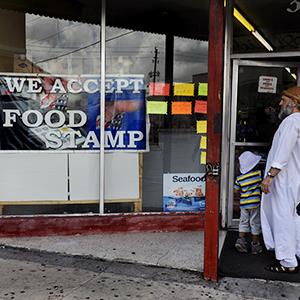The toughest state for getting food stamps
Turns out it's not one of the GOP-led, conservative ones. Liberal California has the lowest participation rate in the country.
By Aimee Picchi
 In the political debate over soaring food-stamp usage, one state stands apart from the rest: liberal California, which ranks as the most efficient U.S. state at keeping residents off the rolls.
In the political debate over soaring food-stamp usage, one state stands apart from the rest: liberal California, which ranks as the most efficient U.S. state at keeping residents off the rolls.Only 55% of eligible Californians received food stamp benefits in 2010, the lowest participation rate of any U.S. state, according to the U.S. Department of Agriculture. Nationally, about three-quarters of eligible Americans sign up for the food aid program.
How does California discourage residents from signing up? Unfriendly offices, tough requirements and confusing applications, according to the Los Angeles Times.
That may please some conservatives who criticize the program as bloated and prone to fraud, but it also may be hindering California's economy, the Times notes. Because the program is funded mainly by the federal government, California is missing out on about $6 billion in potential federal aid that its residents could spend at local food stores.
Even at 55% participation, California is the biggest food-stamp state, on a dollar basis. About $6.48 billion in food aid was distributed to residents in fiscal year 2011, more than any other state, according to the USDA.
The paradox of food-stamp usage is shown in stark relief by looking at Texas, helmed by a Republican governor and known for its right-leaning population.
The Lone Star State had nearly 4 million residents claiming food aid in fiscal 2011, more than California's 3.67 million participants. Texas' food-stamp bill of about $6 billion was lower than California's because Texans get smaller per-person benefits. But about 65% of eligible Lone Star State residents receive the benefit, according to the USDA.
Despite Texas Gov. Rick Perry's vow to slash government spending, the state has eliminated the requirement that food stamp participants get fingerprinted, the Times noted. (California's Gov. Jerry Brown later signed a bill to do away with that requirement.)
Indeed, the reality of food stamp usage doesn't always jibe with political leanings. For instance, 213 of the 254 counties where food stamp usage doubled from 2007 to 2011 voted for Republican presidential candidate Mitt Romney, according to a Bloomberg estimate.
To be sure, several liberal-leaning states have the highest participation of eligible residents. Maine and Oregon, for instance, top the list at 100% participation. But Tennessee, Missouri and Kentucky -- whose voters supported Romney in 2012 -- were among those right-leaning states with higher-than average participation rates.
The food stamp program is also coming under fire from some mayors who want to ban the the benefit's use to buy sodas such as Coca-Cola (KO -0.69%), while health advocacy groups are urging the government to restrict junk-food purchases.
The bottom line, however, is that it's not always in a state's best interest to stem food stamp enrollment because of the benefit to local spending.
Or as senior research fellow Robert Rector of the conservative Heritage Foundation told the L.A. Times: "It would bring them political controversy and no financial gain for their state. It is like asking them to jump into a buzz saw and to bring their governor along."
No comments:
Post a Comment